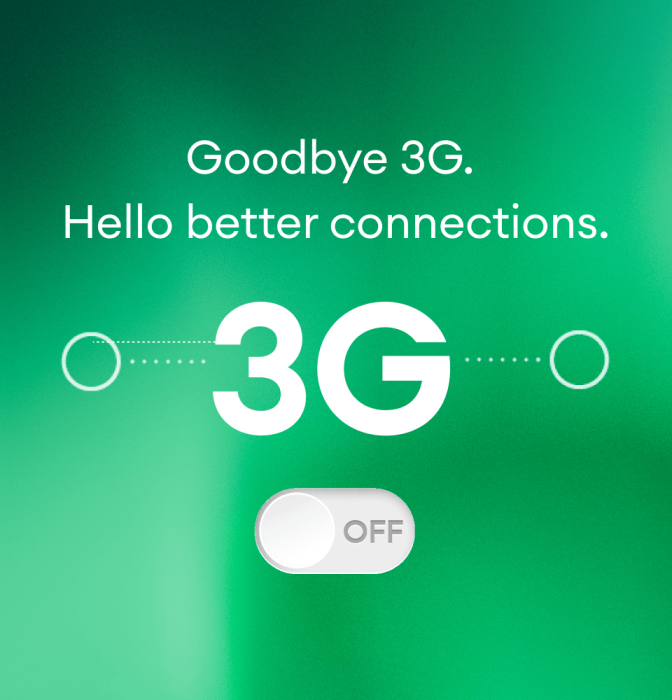Get ready: 3G is shutting down from December.
As the 4G and 5G rollout across Aotearoa increases momentum, it’s now time to look ahead and prepare to farewell our old 3G network from the end of December 2025.
We don’t expect to see any material reduction in coverage overall after our 3G network is switched off. There may be changes to coverage at a limited number of specific locations due to propagation differences of the technologies. If you currently use a device that relies on 3G and don’t upgrade it, you need to be aware that your ability to connect to the coverage will be impacted after 3G network is switched off. Customers can find out if they need to take action by texting ‘3G’ to 550.
Everything you do now on 3G will be significantly better on 4G - and even more so on 5G. Plus, our 5G coverage will continue to expand further as we, like many other mobile network providers worldwide, reallocate resources towards the 5G rollout.
Please ensure that all your phones and devices are ready. We’re here to help you every step of the way.
What can I do now?
Free TXT 3G to 550
- TXT 3G to 550 from your phone and you will receive a TXT confirmation on how your phone is affected and what you need to do to be ready for the 3G shutdown (if anything!).
- Using this SMS service is optional. However, please note that if you do not have a compatible phone, you will no longer be able to use it once the 3G network is shut down.
- If you’re unsure about what your responses mean and to understand how we will use your number when you TXT the SMS checker, check out the FAQs below.
Check that you can make 4G calls - or 5G calls.
- Firstly, the most important thing is to check whether your phone can make mobile voice calls using 4G or 5G, also called “VoLTE”.
- Most smartphones have this capability except for older ones and there are some others that will work in NZ but not when you visit countries that have also shutdown their 3G networks.
- Check your phone's VoLTE capability on our devices list.
Check your phone's software and VoLTE setting.
- If your phone has VoLTE support then great, but we’d still recommend that you make sure you have enabled your phone’s latest software update.
- For Android phones: Go to Settings > Software Update
- For iPhones (iOS): Go to Settings > General > Software Update
- Then check that 4G/5G data is enabled in your phone settings as well as 4G voice calling/VoLTE.
- Head to your mobile network settings and switch the 4G/VoLTE calling toggle to “On"
- For Android phones: Go to Settings > Connections > Mobile networks > VoLTE calls enabled
- For iPhone (iOS) This is usually already enabled for most iPhones: Go to Settings > Mobile > Mobile Data Options > Voice & Data (ensure 4G or 5G is “On”)
- VoLTE roaming capabilities will be important depending on your travel destination. Most of our overseas roaming partners are shutting down their 3G networks.
Phone not listed on our VoLTE capable list.
Using a 2G or 3G phone. You won’t be able to make calls, send TXTs, or use mobile data after the shutdown. Upgrade to a 4G or 5G device to stay connected.
Have an older 4G phone. If it only makes calls over 3G, you’ll need to upgrade to continue making voice and emergency calls.
Using a 4G/5G phone not approved by One NZ. It may still work, but we recommend updating your software and enabling 4G/5G data and VoLTE in your settings. For full compatibility, consider switching to an approved model
Options for upgrading your phone.
- If your team members are on a One NZ monthly Endless Business mobile plan, consider upgrading their phones by buying interest-free. Check out your phone options.
- If some of your team are currently on a One NZ prepay plan, now is a good time to think about switching them to a monthly Endless Business mobile plan instead and taking advantage of the phone deals available on these plans. View business phone deals.
Frequently asked questions
When will 2G and 3G networks switch off?
How will coverage be improved when 3G is switched off?
Why am I hearing a message about the 3G network shutdown when I make a call?
Will in-building coverage solutions be affected when 3G switches off?
Will Circuit Switched Data (CSD) be affected when 3G switches off?
How can our team members improve poor coverage at home?
What happens to team members with older mobile devices when 3G switches off?
What happens to 3G dongles and other 3G-connected devices after the switch-off?
Will my Wireless Modem or Homephone Wireless device be affected?
- 3G only data modems with or without landline calling.
- 4G data modems that use 3G for landline calling (if they are only used for data then no changes are required).
- Homephone Wireless 3G devices used for landline calling.
Don’t worry if you have one of these devices, we will be contacting you soon to let you know exactly what will happen.
How will embedded systems, Machine to Machine (M2M), and Internet of Things (IoT) devices be affected when 3G switches off?
IoT - 3G switch off
What is the Internet of Things (IoT)?
In simple terms, IoT allows everyday objects to "talk" to each other and to us, helping automate tasks, improve efficiency, and provide useful insights. For example, a smart fridge can track food expiry dates, or a GPS tracker in a vehicle can help businesses monitor deliveries in real time.
Learn more about how the 2G and 3G networks shutting down affects One NZ IoT.
Internet of Things Examples
You likely use IoT devices every day. The list below outlines a few examples of IoT in action across our everyday lives and industries:
1. Health Monitoring & Medical Devices
- Smartwatches & Fitness Trackers (e.g., Apple Watch, Fitbit) – Monitor heart rate, sleep, and activity, alerting users to potential health issues.
- Remote Patient Monitoring (RPM) – Devices track blood pressure, glucose levels, or heart rhythms and send real-time data to doctors for early intervention.
2. Smart Homes
- Smart Thermostats – Learn your schedule and adjust temperature to save energy.
- Security Cameras & Doorbells (e.g., Ring, Arlo) – Allow homeowners to monitor and communicate with visitors remotely.
- Smart Appliances – Fridges that track food expiry or washing machines that notify you when a cycle is done.
3. Smart Buildings
- Automated Lighting & HVAC – Sensors adjust lighting and temperature based on occupancy to save energy.
- Leak & Air Quality Sensors – Detect leaks, smoke, or poor air quality to improve safety and reduce maintenance costs.
4. Smart Construction
- IoT Enabled Equipment Monitoring – Sensors on heavy machinery track usage, predict maintenance needs, and reduce downtime.
- Wearable Safety Gear – Smart helmets and vests monitor workers' location and detect falls or fatigue to enhance safety.
- Smart Concrete Sensors – Measure temperature and moisture levels to optimise curing and improve building quality.
5. Lone Worker Safety
- Wearable Panic Buttons – Employees in remote areas can send emergency alerts with GPS location if they need help.
- Fall Detection Devices – Smart sensors detect sudden falls and automatically trigger an alert for assistance.
6. Connected Vehicles & Logistics
- Fleet Tracking – GPS and sensors help businesses monitor trucks, optimise routes, and reduce fuel costs.
- Smart Cars – Some vehicles diagnose mechanical issues and alert the driver or even call emergency services in an accident.
7. Smart Cities & Infrastructure
- Traffic Management – Sensors in roads and traffic lights help reduce congestion.
- Smart Streetlights – Adjust brightness based on movement to save energy.
8. Agriculture & Farming
- Soil Sensors – Monitor moisture levels and optimize irrigation.
- Smart Livestock Tags – Track animal health and location, reducing losses.
Free TXT 3G to 550
How will my phone number be used when I message the SMS checker?
What do my responses mean?
| Message | What it means |
Your phone is only able to connect through 2G or 3G so you’ll need to upgrade to a new phone soon. | Your phone does not have any 4G capabilities. |
| Your phone may work for 4G data but it won’t be able to make 4G voice calls (including emergency calls). | Your phone does not support 4G calling. |
You should upgrade to an approved phone for the best possible coverage.
If you received any of these messages, your phone doesn’t have the technology to receive the best 4G/5G coverage possible.
| Message | What it means |
| Your phone won’t get the best 4G/5G coverage in rural areas or inside large buildings. | This means you may experience poorer coverage when inside large buildings or in rural areas - you may already experience dropped calls. An approved phone upgrade would fix this. |
You need to update your phone settings
If you received one of these messages, your phone may work – but you’ll need to update your phone’s software and enable 4G/5G data and calling (VoLTE). See top of this page for how-to steps.
| Message | What it means |
| Your phone isn’t tested by One NZ. | This means you have a phone model that isn’t tested for 4G/5G calling. |
| Your phone isn’t using 4G/5G for voice calls right now. | Due to your phone’s default setting. |
| Your phone is making 4G/5G calls, but not guaranteed for emergency calls. | As it’s not a phone model that we have tested, we can’t guarantee this. |
You need to update your phone settings
If you received one of these messages, your phone may work – but you’ll need to update your phone’s software and enable 4G/5G data and calling (VoLTE). See top of this page for how-to steps.
| Message | What it means |
| Your phone is using older 2G/3G networks for calls. | Due to your phone’s default setting. |
| Your phone isn’t using the 4G/5G networks right now. | Due to your phone’s default setting. |
| Not currently making 4G/5G calls. | Due to your phone’s default setting. Please switch on 4G/5G calling (VoLTE). |
| If you bought your phone from overseas or from a parallel importer, we can’t guarantee it will work. | We can’t guarantee that your phone will work for 4G/5G voice calls or emergency calling. |
Check again next month.
If you received the message below, it may mean we may not have the latest info just yet. Just check back again next month. If you still have concerns, just contact our team or visit in store.
This phone checker uses best efforts to assess phones but may not be 100% perfect.
| Message | What it means |
| We don’t have any records for your phone. | You may have recently changed your phone or recently signed up as a One NZ. |
| Or have an uncommon model of phone or device we can’t track | We can’t track your phone model or device. |


